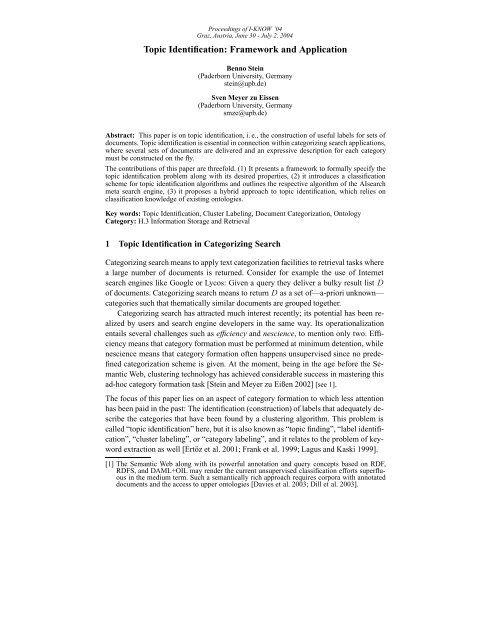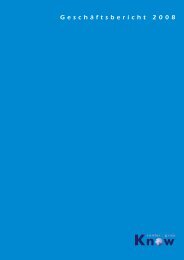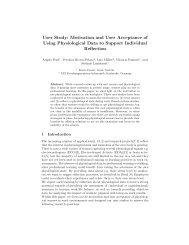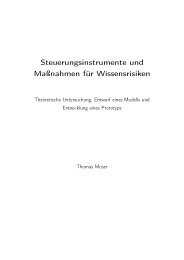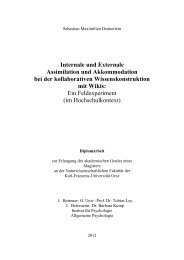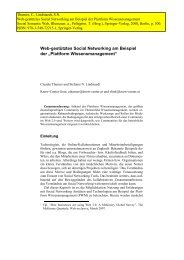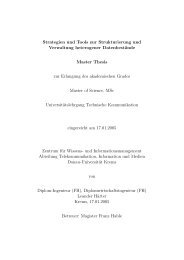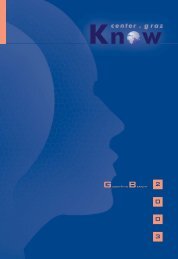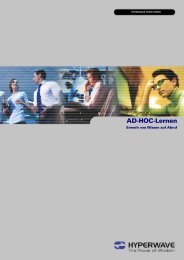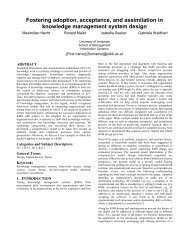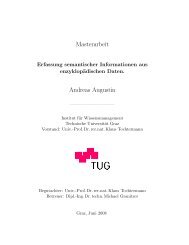Topic Identification: Framework and Application - KnowMiner
Topic Identification: Framework and Application - KnowMiner
Topic Identification: Framework and Application - KnowMiner
You also want an ePaper? Increase the reach of your titles
YUMPU automatically turns print PDFs into web optimized ePapers that Google loves.
Proceedings of I-KNOW ’04<br />
Graz, Austria, June 30 - July 2, 2004<br />
<strong>Topic</strong> <strong>Identification</strong>: <strong>Framework</strong> <strong>and</strong> <strong>Application</strong><br />
Benno Stein<br />
(Paderborn University, Germany<br />
stein@upb.de)<br />
Sven Meyer zu Eissen<br />
(Paderborn University, Germany<br />
smze@upb.de)<br />
Abstract: This paper is on topic identification, i. e., the construction of useful labels for sets of<br />
documents. <strong>Topic</strong> identification is essential in connection within categorizing search applications,<br />
where several sets of documents are delivered <strong>and</strong> an expressive description for each category<br />
must be constructed on the fly.<br />
The contributions of this paper are threefold. (1) It presents a framework to formally specify the<br />
topic identification problem along with its desired properties, (2) it introduces a classification<br />
scheme for topic identification algorithms <strong>and</strong> outlines the respective algorithm of the AIsearch<br />
meta search engine, (3) it proposes a hybrid approach to topic identification, which relies on<br />
classification knowledge of existing ontologies.<br />
Key words: <strong>Topic</strong> <strong>Identification</strong>, Cluster Labeling, Document Categorization, Ontology<br />
Category: H.3 Information Storage <strong>and</strong> Retrieval<br />
1 <strong>Topic</strong> <strong>Identification</strong> in Categorizing Search<br />
Categorizing search means to apply text categorization facilities to retrieval tasks where<br />
a large number of documents is returned. Consider for example the use of Internet<br />
search engines like Google or Lycos: Given a query they deliver a bulky result list D<br />
of documents. Categorizing search means to return D as a set of—a-priori unknown—<br />
categories such that thematically similar documents are grouped together.<br />
Categorizing search has attracted much interest recently; its potential has been realized<br />
by users <strong>and</strong> search engine developers in the same way. Its operationalization<br />
entails several challenges such as efficiency <strong>and</strong> nescience, to mention only two. Efficiency<br />
means that category formation must be performed at minimum detention, while<br />
nescience means that category formation often happens unsupervised since no predefined<br />
categorization scheme is given. At the moment, being in the age before the Semantic<br />
Web, clustering technology has achieved considerable success in mastering this<br />
ad-hoc category formation task [Stein <strong>and</strong> Meyer zu Eißen 2002] [see 1].<br />
The focus of this paper lies on an aspect of category formation to which less attention<br />
has been paid in the past: The identification (construction) of labels that adequately describe<br />
the categories that have been found by a clustering algorithm. This problem is<br />
called “topic identification” here, but it is also known as “topic finding”, “label identification”,<br />
“cluster labeling”, or “category labeling”, <strong>and</strong> it relates to the problem of keyword<br />
extraction as well [Ertöz et al. 2001; Frank et al. 1999; Lagus <strong>and</strong> Kaski 1999].<br />
[1] The Semantic Web along with its powerful annotation <strong>and</strong> query concepts based on RDF,<br />
RDFS, <strong>and</strong> DAML+OIL may render the current unsupervised classification efforts superfluous<br />
in the medium term. Such a semantically rich approach requires corpora with annotated<br />
documents <strong>and</strong> the access to upper ontologies [Davies et al. 2003; Dill et al. 2003].
354<br />
Stein B., S. Meyer zu Eissen: <strong>Topic</strong> <strong>Identification</strong>: <strong>Framework</strong> <strong>and</strong> <strong>Application</strong><br />
At first sight, the adequate labeling of a category seems to be less difficult than its<br />
formation. Category formation by clustering is based on a particular document model<br />
along with a compatible similarity measure. This naturally extends to cluster labeling,<br />
where a cluster C is represented by some kind of a meta document, e. g. the cluster<br />
centroid, c, which is built from the document models of all documents in C. Cluster<br />
labeling then can be understood as a function τ(C) that maps onto a set of descriptor<br />
terms, which usually is a subset of the index terms in c. Following clustering terminology,<br />
this approach should be called “polythetic labeling”: The labeling process is based<br />
on the simultaneous analysis of several features, the index terms [see 2].<br />
While the polythetic approach is justified for cluster formation, say, when analyzing<br />
documents with respect to their similarity [see 3], it is problematic in connection<br />
with cluster labeling. Cluster labels are in the role of concept descriptors in a concept<br />
hierarchy: Ideally, the cluster labels of a (hierarchical) clustering should represent a<br />
conceptualization of the documents in a collection, i. e., they should provide an ontological<br />
view. Observe that a concept hierarchy can be understood as the result of a<br />
monothetic clustering algorithm: In each clustering step, the most general concept t<br />
of the remaining set D ′ of documents is considered as a feature variable with values<br />
t1,...,tk according to which the documents in D ′ are discriminated.<br />
[Figure 1] illustrates the difference between polythetic labeling <strong>and</strong> the selection of concept<br />
descriptors by contrasting the search results of two well-known document retrieval<br />
applications: Vivísimo <strong>and</strong> dmoz. The query term was “Lassie”.<br />
Figure 1: The left-h<strong>and</strong> side shows the topmost level of the category tree that has been generated<br />
by Vivísimo from 150 documents for the query “Lassie”; the category names result from a<br />
polythetic labeling algorithm. The right-h<strong>and</strong> side shows the respective dmoz-categories where<br />
Lassie-documents have been found.<br />
The example of Vivísimo shows that polythetic labeling can produce useful results;<br />
however, when unfolding the Vivísimo category tree, several weak points become ob-<br />
[2] This observation was already made in [S<strong>and</strong>erson <strong>and</strong> Croft 1999].<br />
[3] As various analyses have shown, cluster algorithms are able to resemble a categorization<br />
scheme found by human editors [Zaho <strong>and</strong> Karypis 2002; Han et al. 2001].
Stein B., S. Meyer zu Eissen: <strong>Topic</strong> <strong>Identification</strong>: <strong>Framework</strong> <strong>and</strong> <strong>Application</strong><br />
vious: repeated category names, non-specializing sub-categories, or meaningless category<br />
names. By contrast, the dmoz categories are maintained by human editors, <strong>and</strong> the<br />
query results reflect the editors’ ontological underst<strong>and</strong>ing of the world. The automatic<br />
derivation of such a genuine hierarchy of categories for a given document collection D<br />
is very difficult: researchers have been investigating the combination of sophisticated<br />
techniques such as query expansion, local context analysis (LCA), subsumption analysis,<br />
collocation analysis, or latent semantic indexing (LSI) [Soto 1999]. The results are<br />
often unsatisfactory—not to mention the runtime complexity. Thus, the current practice<br />
of categorizing search engines is to realize topic identification in an “ad-hoc-manner”,<br />
by some kind of index term selection.<br />
The paper in h<strong>and</strong> contributes right here. It renders the topic identification problem<br />
more precisely <strong>and</strong> introduces the topic identification algorithm of the AIsearch meta<br />
search engine. Moreover, the paper proposes a hybrid approach, which relies on the<br />
classification knowledge of existing ontologies, <strong>and</strong> which has the potential to overcome<br />
the problems of current topic identification algorithms.<br />
2 A Formal <strong>Framework</strong><br />
Let D designate a set of documents. A categorization C = {C | C ⊆ D} of D is a<br />
division of D into sets for which the following condition holds: <br />
Ci∈C Ci = D. C is<br />
called an exclusive categorization if Ci ∩ Cj=i = ∅, Ci,Cj ∈C, <strong>and</strong> a non-exclusive<br />
categorization otherwise. The elements in C are called categories. Moreover, we assume<br />
that no categorization scheme is given, which is the normal case for categorizing search<br />
engines: They generate C by means of some clustering approach.<br />
Several clustering algorithms define a hierarchy or can be applied in a recursive<br />
manner, this way defining a hierarchy H C on C. HC is a tree whose nodes correspond<br />
to the categories in C from which one is marked as root node. Given two categories,<br />
Ci,Cj,Ci = Cj, we write Ci ≻ Cj if the corresponding nodes in HC lie on a common<br />
path emanating at the root <strong>and</strong> if Ci is closer to the root than Cj.<br />
The elements in D are abstractions of the interesting documents; they have been<br />
formed according to some document model. In the following we consider a document<br />
data structure d ∈ D as an ordered set of index terms W d = {wd1,...,wdn} along<br />
with a set of functions, which map from Wd to R + , such as the term frequency tf d (w)<br />
or the inverse document frequency idf (w).<br />
Let W = <br />
d∈D Wd be the entire word set underlying C. Then topic identification<br />
means the construction of a function τ that assigns to each element C ∈Ca set T C ⊂<br />
W , say, τ(C) ↦→ TC. τ is called a labeling.<br />
Let C be a categorization. Then the following are desired properties of a labeling τ:<br />
1. Unique. ∀ C i ,C j ∈C<br />
C i =C j<br />
: τ(Ci) ∩ τ(Cj) =∅<br />
2. Summarizing. ∀C∈C ∀d∈C : τ(C) ∩ Wd = ∅<br />
355
356<br />
3. Expressive. ∀C∈C ∀d∈C ∀w∈Wd : tf d(w) ≤ tf d(w ′ ),w ′ ∈ τ(C),<br />
where tf d(w) designates the term frequency of some word w in document d.<br />
4. Discriminating. ∀ C i ,C j ∈C<br />
C i =C j<br />
1<br />
∀w∈WC : i |Ci| tf 1<br />
Ci (w) ≪ |Cj| tf Cj (w′ ),w ′ ∈ τ(Cj),<br />
where WC = <br />
d∈C Wd designates the word set of category C, <strong>and</strong> tf C(w) is the<br />
term frequency of w in category C, say, tf C(w) = <br />
d∈C tf d(w).<br />
5. Contiguous. ∀C∈C ∀ w ′ ,w ′′ ∈τ(C)<br />
w ′ =w ′′<br />
6. Hierarchically Consistent. ∀ C i ,C j ∈C<br />
C i =C j<br />
∀d∈C ∃wi,wi+1∈Wd : wi = w ′ ∧ wi+1 = w ′′<br />
: Ci ≻ Cj ⇒ P (wi|wj) =1∧ P (wj|wi) < 1,<br />
where wi ∈ (Wdi ∩ τ(Ci)), wj ∈ (Wdj ∩ τ(Cj)), di ∈ Ci, dj ∈ Cj.<br />
7. Irredundant. ∀C∈C ∀ w ′ ,w ′′ ∈τ(C)<br />
w ′ =w ′′<br />
: w ′ <strong>and</strong> w ′′ are not synonymous.<br />
Remarks. The stated properties formalize ideal constraints which, in the real world, can<br />
only be approximated. Note that merely Property 6 requires the existence of a category<br />
tree HC. Finally note that hierarchical consistency <strong>and</strong> irredundancy are practically impossible<br />
to achieve if no external knowledge is provided.<br />
3 <strong>Topic</strong> <strong>Identification</strong>: Classifying Existing Approaches<br />
There is only little research which directly relates to topic identification. In the previous<br />
section we thus provided a framework with desired properties for a labeling τ—now<br />
we give a classification scheme for the existing approaches from an operational point of<br />
view. This scheme, illustrated in [Figure 2], does also include strategies that were not<br />
meant for labeling (topic identification) purposes in first place, but that can be utilized<br />
straightforwardly in this respect.<br />
labeling<br />
strategy<br />
Stein B., S. Meyer zu Eissen: <strong>Topic</strong> <strong>Identification</strong>: <strong>Framework</strong> <strong>and</strong> <strong>Application</strong><br />
content-based<br />
monothetic<br />
polythetic<br />
structure-based: title analysis<br />
hierarchy-analyzing:<br />
hierarchy-synthezising:<br />
hierarchy-presuming:<br />
equivalence-presuming:<br />
Bayes classifier,<br />
shrinkage,<br />
neural networks<br />
subsumption analysis<br />
χ 2 -test,<br />
mutual information,<br />
subsumption analysis<br />
frequency analysis,<br />
discriminant analysis<br />
Figure 2: A classification scheme for labeling strategies for document sets; examples for the<br />
respective strategy are noted behind the leafs of the tree. The two encircled strategies form c<strong>and</strong>idates<br />
that ideally complement each other within a hybrid labeling approach (cf. Section 4).<br />
At the first level we distinguish between content-based <strong>and</strong> structure-based labeling<br />
strategies. The former rely on the words of the interesting documents, say, what is called
a document model in information retrieval. The latter analyze a document with respect<br />
to salient text elements, such as a title, an existing keyword list, or typographic emphasis.<br />
Content-based <strong>and</strong> structure-based strategies can be combined, of course. Among<br />
others, a structure-based strategy is pursued in the well-known Scatter/Gather system<br />
[Cutting et al. 1992] <strong>and</strong> in systems for automatic text summarization.<br />
At the second level the content-based strategies divide into monothetic <strong>and</strong> polythetic<br />
labeling approaches; their conceptual differences along with the related impacts<br />
have been discussed at the outset. Polythetic labeling is used in most document categorization<br />
approaches <strong>and</strong> can hence can be regarded as the prevalent topic identification<br />
strategy [Zamir <strong>and</strong> Etzioni 1998; Zaho <strong>and</strong> Karypis 2002; Ertöz et al. 2001; Stein <strong>and</strong><br />
Meyer zu Eißen 2002], to mention only a few. Another important application of polythetic<br />
labeling stems from the field of self-organizing maps, whose interpretation is<br />
quite difficult. Here, labeling algorithms are used to make the structure <strong>and</strong> the information<br />
available in the map easier to underst<strong>and</strong> [Lagus <strong>and</strong> Kaski 1999; Rauber 1999].<br />
If no hierarchical order (a hyponymy) is presumed, the labeling construction techniques<br />
in polythetic labeling rely on word <strong>and</strong> document frequencies, quantization errors, <strong>and</strong><br />
their combination. Otherwise, χ 2 -tests, mutual information gain, or subsumption analyses<br />
are applied [Popescul <strong>and</strong> Ungar 2000].<br />
At the third level the monothetic labeling approaches are further differentiated by<br />
the underlying knowledge source: hierarchy-analyzing approaches use external knowledge,<br />
say, an existing ontology or taxonomy to derive label information. By contrast,<br />
hierarchy-synthesizing approaches use the (internal) knowledge of the given document<br />
collection; they try to construct concept hierarchies by interrelating categorization <strong>and</strong><br />
labeling within a single process [S<strong>and</strong>erson <strong>and</strong> Croft 1999]: A label determines a category<br />
<strong>and</strong> vice-versa.<br />
<strong>Topic</strong> identification that is based on the analysis of an externally provided hierarchy<br />
is a new approach for categorizing search engines, which is introduced in [Section 4].<br />
<strong>Topic</strong> <strong>Identification</strong> in AIsearch<br />
AIsearch [see 4] is a categorizing meta search engine, which is developed at our institute<br />
[Meyer zu Eißen <strong>and</strong> Stein 2002]. The employed topic identification algorithm could be<br />
designated as “weighted centroid covering” <strong>and</strong> is a polythetic, equivalence-presuming<br />
approach. Aside from efficiency its design rationale was a (heuristic) maximization of<br />
the properties 1 – 4 mentioned in [Section 2].<br />
As before, let D be a set of documents over a set of words W , let w be a word<br />
in W , let C = {C1,...C |C|} be a clustering (categorization) of D, <strong>and</strong> let tf C (w)<br />
denote the term frequency of word w in cluster (category) C ∈C. Moreover, let κ :<br />
W ×{1,...,|C|} → C be a function with κ(w, i) =C iff C is the cluster with the<br />
ith frequent occurrence of word w. For example, κ(w, 1) <strong>and</strong> κ(w, |C|) denote those<br />
clusters wherein w occurs most frequently <strong>and</strong> least frequently, respectively.<br />
The algorithm consists of two major parts. At first, a vector T of k ·|W | tuples<br />
〈w, tf κ(w,i)(w)〉, i ∈{1,...,k}, is constructed for the k most frequent occurrences of<br />
[4] www.aisearch.de<br />
Stein B., S. Meyer zu Eissen: <strong>Topic</strong> <strong>Identification</strong>: <strong>Framework</strong> <strong>and</strong> <strong>Application</strong><br />
357
358<br />
Stein B., S. Meyer zu Eissen: <strong>Topic</strong> <strong>Identification</strong>: <strong>Framework</strong> <strong>and</strong> <strong>Application</strong><br />
a word w in C; T is sorted in descending order with respect to the term frequencies. Secondly,<br />
l different words are assigned to each of the clusters, where in each pass exactly<br />
one word is assigned to every cluster (Round-Robin). Observe that by processing the<br />
tuples in T in a top-down manner, the most frequent words in the weighted centroids<br />
of the clusters C ∈Care selected (covered)—which advised us to give the algorithm<br />
its name.<br />
Algorithm: Weighted Centroid Covering (WCC)<br />
Input: A clustering C.<br />
l. Specifies how many terms make up a label.<br />
k. Specifies how often the same word may occur in the label of different clusters.<br />
Output: A labeling function τ.<br />
WCC(C,l,k)<br />
1. T = ∅;<br />
FOREACH C IN C DO τ(C) =∅;<br />
2. FOREACH w IN W DO<br />
FOR i =1 TO k<br />
compute C = κ(w, i) from C;<br />
add tuple 〈w, tf C (w)〉 to T ;<br />
ENDFOR<br />
ENDDO<br />
3. SORT T descending with respect to the term frequencies;<br />
4. FOR labelcount =1 TO l<br />
assigned = 0 ; j =1;<br />
WHILE assigned < |C| AND j ≤|T|<br />
let tj = 〈w, tf C(w)〉 denote the jth tuple of T ;<br />
IF |τ(C)| < labelcount THEN<br />
τ(C) =τ(C) ∪{w};<br />
delete tj from T ;<br />
assigned = assigned +1;<br />
ENDIF<br />
j = j +1;<br />
ENDWHILE<br />
ENDFOR<br />
5. RETURN τ;<br />
The labeling τ generated by WCC fulfills the properties 1 <strong>and</strong> 2 by definition of κ; the<br />
cluster-wise Round-Robin-strategy aims at fulfilling Property 3. A small k as parameter<br />
helps fulfilling Property 4. Computing the κ-values (including sorting) is in O(k ·|W |·<br />
log(k·|W |)); assigning the labels is in O(l·k·|W |). Since k <strong>and</strong> l are typically bounded<br />
by a small constant, the overall complexity is in O(|W |·log(|W |)).<br />
4 Hybrid <strong>Topic</strong> <strong>Identification</strong> Using Upper Ontologies<br />
The preparation of search results D in the form of a category tree H C will be of maximum<br />
value for each human information miner, if—but only if(!)—both the related<br />
labeling provides an ontological view onto D <strong>and</strong> the documents in the categories obey<br />
the conceptualization of this ontology.<br />
Clearly, even for a large set of search results a category tree H C can be generated<br />
easily by a hierarchical clustering approach [El-Hamdouchi <strong>and</strong> Willett 1989]. However,<br />
the resulting labeling τ, which is based on H C, is usually far away from being
Stein B., S. Meyer zu Eissen: <strong>Topic</strong> <strong>Identification</strong>: <strong>Framework</strong> <strong>and</strong> <strong>Application</strong><br />
a useful taxonomy. In particular, the properties 6 <strong>and</strong> 7 of the framework cannot be<br />
fulfilled.<br />
We believe that the weaknesses of topic identification algorithms in categorizing<br />
search engines could be overcome if external classification knowledge were brought<br />
in. We now outline the ideas of such an approach where both topic descriptors <strong>and</strong> hierarchy<br />
information from an upper ontology are utilized. Let C = C 1,...,Cm be the<br />
categorization constructed by a clustering algorithm for a set D of search results. Moreover,<br />
let O = O1,...,Ol be a reference categorization of a set of documents D O, let<br />
τO be a labeling of O that provides an ontological view onto D O, <strong>and</strong> let the documents<br />
in the Oj obey the conceptualization of this ontology. Then, topic identification is based<br />
on the following paradigms:<br />
1. Initially, no hierarchy (refines-relation) is presumed among the C ∈C. This is in<br />
accordance with the observations made in [Ertöz et al. 2001].<br />
2. Each category C ∈Cis associated to its most similar set O ∈O. If the association<br />
is unique, τO(O) is selected as category label for C.<br />
3. Categories which cannot be associated uniquely within O are treated by a polythetic,<br />
equivalence-presuming labeling strategy in a st<strong>and</strong>ard way.<br />
In essence, finding a labeling for a categorization C using an ontology O means<br />
to construct a hierarchical classifier, since one has to map the centroid vectors of the<br />
clusters C ∈Conto the best-matching O ∈O. Note that a variety of machine learning<br />
techniques has successfully been applied to this problem; they include Bayesian<br />
classifiers, SVMs, decision trees, neural networks, regression techniques, <strong>and</strong> nearest<br />
neighbor classifiers.<br />
5 Summary <strong>and</strong> Current Work<br />
359<br />
<strong>Topic</strong> identification means to construct a list with few words (= label) to characterize a<br />
set of documents. In categorizing search we have a set C of such document sets, <strong>and</strong> the<br />
construction of a set of meaningful labels (= labeling τ) is both important <strong>and</strong> difficult,<br />
since label construction may not happen isolated for each category C ∈C. The paper<br />
in h<strong>and</strong> presents a framework with desired properties of such a labeling τ. Moreover,<br />
it classifies existing approaches that may be used for topic identification purposes, it<br />
gives an algorithmic specification of the topic identification algorithm in AIsearch, <strong>and</strong><br />
it proposes a topic identification strategy that relies on existing ontologies.<br />
The new approach has the potential to overcome the problems of current topic identification<br />
algorithms—in particular, it solves the problem of term selection <strong>and</strong> hierarchy<br />
construction—<strong>and</strong> our experiments are promising in this respect. Nonetheless, we<br />
have not presented a comparative analysis here for the following reasons: (1) Our experiments<br />
relate to selected parts of the dmoz-ontology, <strong>and</strong> there is the question to what<br />
extent they may be generalized; (2) there is no simple measure to compare topic identification<br />
algorithms. A comprehensive analysis requires a detailed description of the
360<br />
Stein B., S. Meyer zu Eissen: <strong>Topic</strong> <strong>Identification</strong>: <strong>Framework</strong> <strong>and</strong> <strong>Application</strong><br />
underlying queries, document collections, <strong>and</strong> linguistic measures, which goes beyond<br />
the scope of this paper[see 5].<br />
Of course, the new approach also rises new questions; perhaps the most crucial is<br />
the question of how to obtain a useful <strong>and</strong> “complete” upper ontology.<br />
References<br />
[Cutting et al. 1992] Douglass R. Cutting, David R. Karger, Jan O. Pedersen, <strong>and</strong> John W.<br />
Tukey. Scatter/Gather: A cluster-based approach to browsing large document collections. In<br />
Proceedings of the 15th ACM SIGIR Conference, pages 318–329. ACM Press, 1992.<br />
[Davies et al. 2003] John Davies, Dieter Fensel, <strong>and</strong> Frank van Harmelen. Towards the Semantic<br />
Web: Ontology-Driven Knowledge Management. John Wiley & Sons, New York, 2003.<br />
[Dill et al. 2003] S. Dill, N. Eiron, D. Gibson, D. Gruhl, R. Guha, A. Jhingran, T. Kanungo,<br />
S. Rajagopalan, A. Tomkins, J. A. Tomlin, <strong>and</strong> J. Y. Zien. SemTag <strong>and</strong> Seeker:<br />
Bootstrapping the Semantic Web via Automated Semantic Annotation. In Procc of the 12th<br />
Int. Conference on the WWW, pages 178–186. ACM Press, May 2003.<br />
[El-Hamdouchi <strong>and</strong> Willett 1989] A. El-Hamdouchi <strong>and</strong> P. Willett. Comparison of Hierarchic<br />
Agglomerative Clustering Methods for Document Retrieval. The Computer Journal, 32(3):<br />
220–227, 1989.<br />
[Ertöz et al. 2001] L. Ertöz, M. Steinbach, <strong>and</strong> V. Kumar. Finding <strong>Topic</strong>s in Collections of<br />
Documents: A Shared Nearest Neighbor Approach. In Proceedings of the Text Mine ’01,<br />
Workshop on Data Mining, 1st SIAM International Conference on Data Mining, 2001.<br />
[Frank et al. 1999] E. Frank, G. W. Paynter, I. H. Witten, C. Gutwin, <strong>and</strong><br />
C G. Nevill-Manning. Domain-Specific Keyphrase Extraction. In Proc. of the 16th<br />
International Joint Conference on Artificial Intelligence, pages 668–673. 1999.<br />
[Han et al (2001] Eui-Hong Han, George Karypis, <strong>and</strong> Vipin Kumar. Text Categorization Using<br />
Weight Adjusted k-Nearest Neighbor Classification. In Pacific-Asia Conference on<br />
Knowledge Discovery <strong>and</strong> Data Mining, pages 53–65, USA, 2001. University of Minnesota.<br />
[He et al. 2001] X. He, C. H. Q. Ding, H. Zha, <strong>and</strong> H. D. Simon. Automatic <strong>Topic</strong> <strong>Identification</strong><br />
Using Webpage Clustering. In Proc. of ICDM’01, pages 195–202, November 2001.<br />
[Lagus <strong>and</strong> Kaski 1999] K. Lagus <strong>and</strong> S. Kaski. Keyword Selection Method for Characterizing<br />
Text Document Maps. In Proc. of ICANN’99, pages 371–376. IEEE, 1999.<br />
[Meyer zu Eißen <strong>and</strong> Stein 2002] S. Meyer zu Eißen <strong>and</strong> B. Stein. The AISEARCH Meta Search<br />
Engine Prototype. Proc. of the 12th Workshop on Information Technology <strong>and</strong> Systems (WITS<br />
02), Barcelona, Spain. December 2002.<br />
[Popescul <strong>and</strong> Ungar 2000] A. Popescul <strong>and</strong> L. H. Ungar. Automatic Labeling of Document<br />
Clusters. http://citeseer.nj.nec.com/popescul00automatic.html, 2000.<br />
[Rauber 1999] A. Rauber. LabelSOM: On the Labeling of Self-Organizing Maps. In Proc. of<br />
IJCNN’99. IEEE, July 1999.<br />
[S<strong>and</strong>erson <strong>and</strong> Croft 1999] M. S<strong>and</strong>erson <strong>and</strong> W. B. Croft. Deriving Concept Hierarchies from<br />
Text. In Research <strong>and</strong> Development in Information Retrieval, pages 206–213, Berkley, 1999.<br />
[Soto 1999] R. Soto. Learning <strong>and</strong> performing by exploration: label quality measured by latent<br />
semantic analysis. In Proceedings of CHI’99, pages 418–425. ACM Press, 1999.<br />
[Stein <strong>and</strong> Meyer zu Eißen 2002] B. Stein <strong>and</strong> S. Meyer zu Eißen. Document Categorization<br />
with MAJORCLUST. Proc. of the 12th Workshop on Information Technology <strong>and</strong> Systems<br />
(WITS 02), Barcelona, Spain, pages 91–96. December 2002.<br />
[Zaho <strong>and</strong> Karypis 2002] Y. Zaho <strong>and</strong> G. Karypis. Criterion Functions for Document<br />
Clustering: Experiments <strong>and</strong> Analysis. Tech. Report 01-40, Univercity of Minnesota, 2002.<br />
[Zamir <strong>and</strong> Etzioni 1998] O. Zamir <strong>and</strong> O. Etzioni. Web Document Clustering: A Feasibility<br />
Demonstration. In Proc. of the 21st ACM SIGIR conference, pages 46–54, USA, 1998.<br />
[5] In an upcoming technical paper we will report on a comparison of the topic identification<br />
algorithms of different categorizing search engines.


